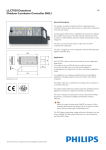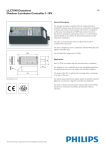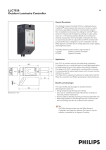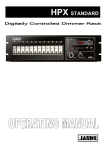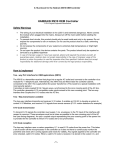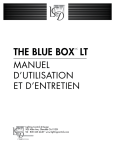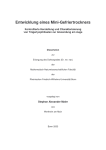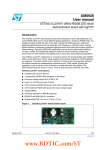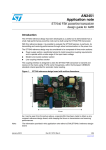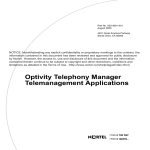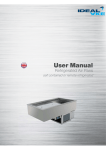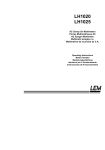Download OLC 7030 - Philips Lighting
Transcript
LLC7030 Datasheet Outdoor Luminaire Controller DALI 1/5 General Description The Outdoor Luminaire Controller (OLC) is a high-performance LonWorks® network device that connects to a lamp-driver combination to control and monitor. Communication with the OLC is established via the power line utilizing the LonTalk® open protocol. It interacts with the lamp driver by means of a DALI interface and when needed, switching its output. Because of the DALI interface it is possible to control more lamps with less OLC’s, compared to the 1 – 10V OLC. The OLC makes use of the DALI commands and therefore extra data from the driver will be available in the Starsense system. The OLC can autonomously switch its output ON and OFF if combined with a photocell. 141.5 63 OLC LLC7030/00 8222 740 39903 The OLC is designed to work in combination with the Philips Segment Controller (SC) in a Philips Starsense outdoor lighting telemanagement system. Test 2 1 37.5 M6 Applications Each LLC7030 is able to monitor and control up to two independent lamp-driver combinations. 156 It is designed for use in highway, residential, street and road lighting applications including parking lots, ports, train stations and industrial complexes. Dimensions in mm The design of the OLC is optimized for mounting within a luminaire. 05 It is recommended for optimal performance to connect not more than 70 OLC’s to one SC if the two DALI outputs are used (so 140 drivers) or 140 OLC’s if only one DALI output is used. The Philips OLC is released and authorized to solely interact with the Philips SC, consult the local Philips representative if desired otherwise. When you switch the lamp-driver on/off by a DALI command, there is the possibility to use the Switched Line Output for another type of load, like an advert light or Christmas lights. The LLC7030 OLC DALI doesn’t measure energy consumption; this information is gathered from the driver. For advanced metering you may use the LLC7035 OLC DALI that integrates a meter chip with high accuracy energy metering. Tip The Philips Starsense system uses the Philips Starsense Configurator and Supervisor software. The license to use this software is embedded in the Segment Controller. LLC7030 Datasheet Outdoor Luminaire Controller DALI General operation The OLC combines three main functions: 1The controller function receives the incoming commands from the SC and acts accordingly. 2The OLC switches the Line Output and communicates with the lamp-driver via the DALI interfaces. 3The monitor function reports data on current, mains voltage, mains frequency, power factor, burning hours and power consumption of the connected lamp-driver combination. This information is used to determine condition of the lamp-driver combination. A default configured OLC will switch ON its output at maximum level on power-up. 2/5 Wiring Diagram Li The OLC is equipped with a power line transceiver, which can repeat messages. The SC monitors and controls the dynamic repeating functionality centrally. If communication fails between the SC and a specific OLC, another OLC can be designated dynamically by the SC, which can repeat messages. The SC will autonomously and continuously keep track of which OLC’s can be reached directly and which ones require message repeating. Mounting information The OLC is designed to be installed inside a luminaire, but can also be mounted in the pole, gear-trays and separate boxes. If the OLC is mounted inside a pole it may only be mounted upright. The OLC may be mounted in any position if the enclosure is IP43 or above. Please also refer to the installation instruction of the LLC7030. Released drivers Currently the lamp-drivers released to interact with the DALI outputs of the OLC are: • PHILIPS HID-DV DALI 100/150W SON/CDM with lamps SON and CDM-TT • PHILIPS HID-DV DALI Xtreme driver with CPO (Cosmopolis) lamps 60, 90, 140 W • PHILIPS HF-Regulator II Touch and DALI for PL-L, PL-T, PL-C lamps Any other component must be validated before it may be used with the OLC. Contact your local Philips representative about how to obtain component validation. Warning The DALI interface is not using safety isolation (DA- is internally connected to the Neutral conductor). Disconnect the main power supply before servicing. Ni No Lo Ls Max. 6A DALI is not using safety isolation Lc DA- DA+ DA- DA+ 10 - 11 mm DALI driver 1 L DALI driver 2 N Li = Line input Ni = Neutral input No = Neutral output A backup scenario (safeguard mechanism) is available and can be configured in different ways. Refer to page 4 of this document and the Starsense Configurator Manual for more information on this topic. Repeating 0.25 - 2.5 mm2 Filter Ls = Switched Line output Lc = Controlled Line input [Photo cell] 0.25 - 2.5 mm2 Filter Li Ni No Lo Ls DALI is not using safety isolation Lc DA- DA+ DA- DA+ Advert light Max. 6A L N Li = Line input Ni = Neutral input No = Neutral output DALI driver 1 DALI driver 2 Lo = Line output (not switched) Ls = Switched Line output Lc = Controlled Line input [Photo cell] 10 - 11 mm LLC7030 Datasheet Outdoor Luminaire Controller DALI User interface The LLC7030 has two pushbuttons. One is for testing the lamp-driver combination and one to send its unique Neuron® ID number to the Segment Controller (see Starsense System User Manual for more information). The test button can also be used as maintenance indicator. 3/5 Test button • Pressing the test button while the output is OFF will switch the output ON for 15 minutes at maximum. The output will be turned OFF after the timer has expired. During this period the red LED 1 blinks slowly. • Pressing the test button while the output is at maximum level will cause the output to switch for 15 minutes at dimmed level. The output will be turned OFF after the timer has expired. During this period the red LED 1 blinks rapidly. • Pressing the test button while the output is ON at a dimmed level will switch the output OFF. Status LEDs Attention The OLCs output will be switched OFF after 15 minutes. Power cycle the OLC to have the output automatically switched to its configured power-up level. Power LED Maintenance identification After maintenance has been done on an OLC, press the test button for 4 seconds, an identification message will be send via powerline and will be made visible in the supervisor software. Neuron LED Neuron® ID Each OLC has a unique fixed 48-bit identifier called Neuron® ID. The Neuron® ID is printed on the three barcode labels placed on the front of the OLC, which barcode readers can read. Status LEDs LED 1 and 2 will show which output is switched ON. Power LEDWill show device- or output status, if it’s continuously in blinking mode the OLC is in error mode, consult your local Philips representative. Neuron LED Will show when Neuron® ID is send. The yellow service LED indicates the internal OLC state: ON: Application-less.The OLC has only communication parameters loaded. Blinking: Unconfigured.This OLC state indicates that it has communication parameters and an application program and network address information. This OLC state is the “idle” state. Commissioning and configuration need to be performed. OFF: Configured. From the factory the OLC is configured for a default lamp and is operating normally. OLC label Attention When the OLC is installed it is vital for the Starsense system operation that it knows the Neuron® ID and the location of the device. A drawing or list indicating which Neuron® ID belongs to which installed OLC acts as an input for creating the Starsense telemanagement configuration off-line. Tip See Starsense System User Manual for usage suggestions. LLC7030 Datasheet Outdoor Luminaire Controller DALI Powering the OLC ON Apply mains power to the OLC once it is mounted securely and all its wiring is connected as shown in the typical wiring diagram. After power-up, both red LEDs will come ON for 3 seconds. The unit is fully operational and ready for commissioning and configuration after both red LEDs go OFF. The green power LED should stay ON continuously indicating that power is applied and the OLC is running in a correct mode. The OLC is now in its default configuration. The safe-guard mechanisms, burning hours counter, power-up behavior and manual interfaces are operational. Status messages The OLC continuously monitors the current internal temperature. Each newly generated status message is time-stamped. Only the last two status messages are available via power line messages. Energy consumption and burning hours are stored in non-volatile OLC memory and can be obtained, together with status messages, by the SC and Starsense Supervisor software. Safe-guard mechanism with photocell The OLC can (configuration property) fall back onto photocell operation when it detects a communication failure with the SC. This safe-guard mechanism prevents light points from staying OFF during the night, causing dangerous situations, and from staying ON during the day, which would waste energy. The OLC is equipped with one single-pole 230VAC input to monitor the photocell operation. When in safe-guard mode, the OLC will follow the photocell input with its output. A factory default OLC will switch to the safe-guard state if a 230VAC voltage level is detected on the photocell input. Note: It is only possible to connect photocells which use an electromagnetic relay. “Door open” detection The photocell input can also be used as a “door open” detector. Refer to the Starsense System User Manual on how to configure and use this feature. Safe-guard mechanism with back-up scheduler When no photocell is being used the back-up scheduler can be used. The OLC can (configuration property) fall back to run according to a pre-configured schedule when it detects a communication failure with the SC. The OLC will use this back-up schedule to switch its output. It runs on its own internal real-time clock if it is in this stand-alone mode. The switch ON level can be pre-configured through the OLC power-up value. 4/5 Daylight control based on photocell operation When in daylight control mode (configuration property), the OLC will follow the photocell input with its output while still receiving and executing the dimming levels from the segment controller. In this way the switching points are controlled by the available sunlight and the light level is controlled by the Starsense system. Lamp-ballast monitoring is enabled within daylight control. The following functional table is foreseen for photocell use. Photocell detection Dusk Dawn Photocell relay Closed Open Photocell Line out Mains voltage Nothing Technical data Operating conditions Temperature -25°C to +70°C Relative humidity 10% to 90% Max. housing temperature +75°C (on Tc spot, see OLC cover) If the Tc rises beyond 85ºC during use, the OLC will switch off the relay (load). Non-operating conditions Temperature Relative humidity Mains connection Mains voltage Mains frequency Max. load wattage Power consumption Stand-by wattage Connector block Mains connector Wire cross section [mm2] Wire cross section [AWG] Wire strip length -40°C to +85°C 5% to 90% 220-240V ± 10% 50/60 Hz ± 5% 1000W (2 x 400W) DALI drivers including advert light <2W WAGO 804 series contact cage clamp connection 0.25 - 2.5 mm2 solid 0.25 - 2.5 mm2 fine stranded 0.25 - 1.5 mm2 fine stranded with ferrule and plastic collar 0.25 - 2.5 mm2 fine stranded with ferrule, without plastic collar 20-12 AWG solid 10-11 mm LLC7030 Datasheet Outdoor Luminaire Controller DALI 5/5 Power line interface Channel type PL-20C power line Coupling Line-to-Neutral, Non-Isolated Coupling Protocol ANSI/EIA 709.1 Power line transceivers Compliant to ANSI/EIA 709.2 Frequency band CENELEC consumer band: C-band (132.5kHz), automated B-band (110kHz) selection if communication on C-band fails Approval FCC and CENELEC EN50065-1 compliant. RoHS directive 2002/95/EC REACH SVHC Filter Internal band stop filter, to filter interference from the lamp driver. DALI interface Interface Number if interfaces Max. load LLC7030 OLC DALI Ordering Data Type LLC7030 OLC DALI 322 636 36123 03/2011 Data subject to change www.philips.com/lightingcontrols Flammability Glow wire test Protection class Dimensions Weight (PC+ABS Blend) UL 94V-0 at 1.5mm thickness 850°C IP20 in any position IP22 in upright position H: 15.6 cm, W: 6.3 cm, D: 6.3 cm 0.31 kg Standards Safety Immunity Emission EN61347-2-11 EN61547; EN50065-2-1 CISPR15 edition 7.1 Compliant to IEC 60929:2004 Annex E 2 individual digital control outputs 8mA per output Photocell input Input Suitable for magnetic relay type photocell (without snubber) Indicators Power LED (green) This LED is on when the OLC has power. Service LED (yellow) This LED is normally off. Blinking indicates that the application is in un-configured state. Output LED (red 2x) 2 red LEDs labelled 1 and 2, which indicate the output state of DALI output 1 and 2. Manual controls Service button (yellow): Send Neuron® ID Test button (orange): Change output states 1 and 2 (100%-50%-OFF) Barcode code Code128 (Neuron ID) Back-up scheduler Accuracy ± 0.7% Safety pre-fuse requirement Max. value pre-fuse: 6 ATH Packing data Type Housing MaterialBayblend® KU 2-1514 Box dimensions (mm) 295 x 385 x 165 MOQ 1 LonWorks and Neuron are trademarks of the Echelon Corporation registered in the United States and other countries. Qty Material 24 cardboard Ordering number 9137 003 38703 EAN code level 1 87115 59732817 Weight (Kg) net 4.99 EAN code level 3 87115 59732831 gross 5.08 EOC 732817 99





